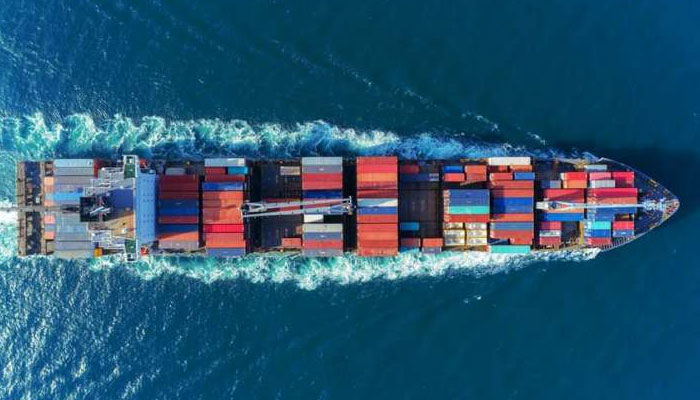Trade deficit narrows 27pc in FY2020; exports falter
KARACHI: Trade deficit narrowed 27.1 percent to $23.1 billion in the last fiscal year of 2019/20, but the reduction was mainly caused by suppressing imports rather than export sector’s recovery, official data showed on Friday.
Pakistan Bureau of Statistics (PBS) data showed that exports declined 6.8 percent to $21.3 billion, whereas imports sharply fell 18.6 percent to $44.5 billion during the last fiscal year.
Analysts said government attributed declining exports to the pandemic, but even if its impact on two months is neglected exports would show a flat growth year-over-year. Exports amounted to $22.9 billion in FY2019.
June exports recovered 14 percent month-on-month and decreased 6.5 percent year-on-year, according to the PBS.
Textile industry’s representative Jawed Bilwani said the problem lies in inconsistency in policies and ignorance of ground reality. “Exporters should be taken onboard and their proposals be implemented,” Bilwani said. He said a major double-digit boost in annual exports for the fiscal year ended on June 2018 was due to textile policy implementation and redressal of genuine concerns of the exporters.
Exporters called for fast settlement of their refund claims and outstanding payments of drawback of local taxes and levy to ease liquidity crunch in the aftermath of coronavirus.
“The pandemic-triggered waning demand hurt global trade and its negative implications could be lessened through focus on exports,” said another home textile exporter, requesting anonymity. “Losses could be compensated and market opportunities could be seized if government focuses on resolving liquidity problems.”
The government abolished zero-rated regime for exporters and applied 17 percent sales tax. While the government claimed that refund issue had been resolved with the introduction of fully automated sales tax e-refund, exporters said 25 percent of them are still to receive their payments.
The analysts said the government seems to rely on loans to bolster foreign exchange reserves instead of export sector and that reflected in performance of manufacturing sector.
The incumbent government resorted to curtail imports and mobilise foreign funds to improve balance of payments position since it took over in August 2018. The International Monetary Fund’s loan program opened up inflows from other multilateral and bilateral foreign institutions to currently elevate the foreign exchange reserves to near $19 billion from $14.4 billion till end of the last fiscal year. However, exports to GDP ratio is teetering below 10 percent. Pakistan’s competing economies in the region are moving towards prosperity because of skilled manpower and growing literacy rate.
-
 Kate Gosselin Reveals Horrowing Moment Thief Nearly Took Her Down
Kate Gosselin Reveals Horrowing Moment Thief Nearly Took Her Down -
 Billy Bob Thornton Weighs In On Contrast To 'Landman' Role
Billy Bob Thornton Weighs In On Contrast To 'Landman' Role -
 Amanda Holden May Swap Position To Different Reality Show: See Which
Amanda Holden May Swap Position To Different Reality Show: See Which -
 The Truth Behind Victoria Beckham's 'inappropriate' Wedding Dance Video
The Truth Behind Victoria Beckham's 'inappropriate' Wedding Dance Video -
 AI Startup Raises $480 Million At $4.5 Billion Valuation In Earlier Gains
AI Startup Raises $480 Million At $4.5 Billion Valuation In Earlier Gains -
 North Carolina Woman Accused Of Serving Victims With Poisoned Drinks
North Carolina Woman Accused Of Serving Victims With Poisoned Drinks -
 Robert Redford’s Daughter Amy Sings Praises Of Late Father
Robert Redford’s Daughter Amy Sings Praises Of Late Father -
 OpenAI And ServiceNow Team Up To Embed ChatGPT In Business Workflows
OpenAI And ServiceNow Team Up To Embed ChatGPT In Business Workflows -
 Johnny Depp Prepares For His Massive Comeback After Years Of Struggle
Johnny Depp Prepares For His Massive Comeback After Years Of Struggle -
 Meghan Markle Is Ready To Put A Cork In It All By Giving Prince Harry Baby No. 3: ‘She Wants A Break’
Meghan Markle Is Ready To Put A Cork In It All By Giving Prince Harry Baby No. 3: ‘She Wants A Break’ -
 Billie Eilish Speaks Out Against Authority: 'It's Very Strange'
Billie Eilish Speaks Out Against Authority: 'It's Very Strange' -
 'Greenland Will Stay Greenland', Former Trump Adviser Hints At New Twist
'Greenland Will Stay Greenland', Former Trump Adviser Hints At New Twist -
 Brooklyn Beckham's Wedding Dance With Mom Victoria Sparks Hilarious Memes
Brooklyn Beckham's Wedding Dance With Mom Victoria Sparks Hilarious Memes -
 King Charles' Latest Photos A Statement On His Health?
King Charles' Latest Photos A Statement On His Health? -
 Tom Cruise's Biggest Dream Crushed By The President?
Tom Cruise's Biggest Dream Crushed By The President? -
 King Charles, Queen Camilla Send Message To King Of Spain After Train Crash
King Charles, Queen Camilla Send Message To King Of Spain After Train Crash




